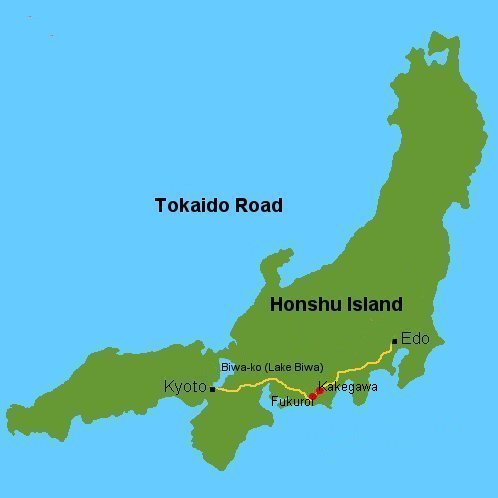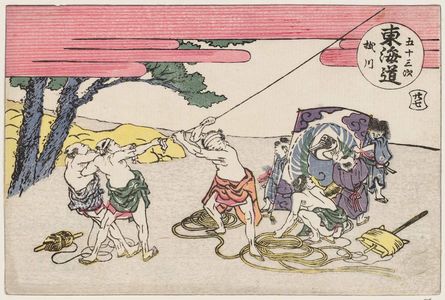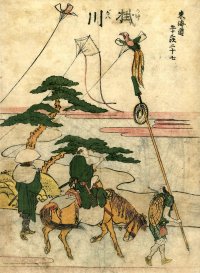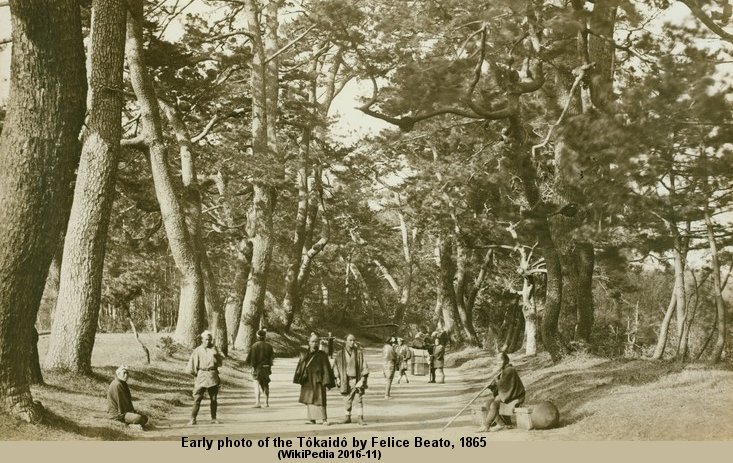| |
|
|
The Tōkaidō (東海道 - literally, the 'Eastern Sea
Road') was the main road of feudal Japan. It ran for roughly
five hundred kilometers between the old imperial capital,
Kyōto, where the Emperor still lived, and Edo (nowadays
Tokiyo), home of the Shōgun
as de facto military ruler.
More detailed information on the Tokaido is to be found in
the chapter about Hiroshige's
editions of the "53
Stations of the Tokaido" and a plethora of Tokaido series from other
leading artists of these times.
A complete sequence of images of the stations
first appeared in 1797 in a six-volume work Tōkaidō meisho zue
(東海道名所図絵, i.e. "Pictures of sights of the Tōkaidō"). This work
involved more than 25 artists, was printed in Kamigata (Osaka)
and showed the stations in the order from Kyoto to Edo.
In 1798 Chōki (長喜) published Gojūsan Tsugi prints that were used as game boards for a Sugoroku game. Shortly thereafter, Toyohiro (豊広) published a series called Tōkaidō meisho, in which genre scenes dominate the depiction of the stations for the first time. In 1801, Hokusai published the first of his various Tokaidō series. In 1804, Kitagawa Utamaro used the "53 Stations" as cartouches in a series depicting beautiful women (bijinga). Katsushika Hokusai created seven smaller-format series on the subject between 1804 and 1825. All series focus on life and hustle and bustle at the individual stations. Even before Hiroshige, the two Hokusai students designed Hokuju and Hokkei Tōkaidō series.
Around 1832, Hiroshige began publishing his first tōkaidō series, The 53 Stations of the Tōkaidō, known as the Hoeidō Tōkaidō. Most of the prints in the series are inspired by illustrations from well-known travel guides such as the above-mentioned "Tōkaidō meisho zue", compiled by Akisato Ritō in 1797 and repeatedly revisited in the following years. The liveliness and authenticity of the scenes depicted made the series a mega hit by today's standards (up to 20,000 casts were made for each station).
Even before Hiroshige had completed his series, Utagawa Kunisada designed a chuban format Tokaido series with beautiful women in the foreground and four-fifths of the prints in which he used his friend Hiroshige's designs for the background. Hiroshige created another 25 Tōkaidō series in his life, Kunisada also almost 20. One of these series was designed by both of them together and another series was Utagawa Kuniyoshi (1798-1861) the third artist who contributed designs. Kuniyoshi's first own Tōkaidō series was created in 1835 and he also designed other series in the period that followed. Series with Tōkaidō motifs are also known from Keisai Eisen, Yoshiharu and Yoshiiku and several other leading artists.
In 1863 'Tōkaidō meisho no uchi' was one of the most extensive series ever published in Japan during the Edo period. On a total of 162 sheets, designed by 16 artists and published by 24 publishers, it describes the first and only journey that a shogun ever made to the imperial palace in Kyoto and which also symbolizes the end of the Edo period. commemorate the procession from Edo to Kyoto by Shogun Iemochi to pay his respect to the emperor. In 1863 the Tokugawa shogunate was in a state of final weakness and dissolution. The procession and the print series were like a last glittering of a glorious past. But it seems, none of those prints contains kites.
Under Tokugawa Iemochi's (徳川家茂) successor, Tokugawa Yoshinobu (徳川慶喜), 1866–67 tenure, the rule of the shoguns ended in 1867 with the return of power to the tennō. This is referred to as the so-called 'Meiji Restoration', named after the reign of the Meiji Tenno (明治天皇).
In 1798 Chōki (長喜) published Gojūsan Tsugi prints that were used as game boards for a Sugoroku game. Shortly thereafter, Toyohiro (豊広) published a series called Tōkaidō meisho, in which genre scenes dominate the depiction of the stations for the first time. In 1801, Hokusai published the first of his various Tokaidō series. In 1804, Kitagawa Utamaro used the "53 Stations" as cartouches in a series depicting beautiful women (bijinga). Katsushika Hokusai created seven smaller-format series on the subject between 1804 and 1825. All series focus on life and hustle and bustle at the individual stations. Even before Hiroshige, the two Hokusai students designed Hokuju and Hokkei Tōkaidō series.
Around 1832, Hiroshige began publishing his first tōkaidō series, The 53 Stations of the Tōkaidō, known as the Hoeidō Tōkaidō. Most of the prints in the series are inspired by illustrations from well-known travel guides such as the above-mentioned "Tōkaidō meisho zue", compiled by Akisato Ritō in 1797 and repeatedly revisited in the following years. The liveliness and authenticity of the scenes depicted made the series a mega hit by today's standards (up to 20,000 casts were made for each station).
Even before Hiroshige had completed his series, Utagawa Kunisada designed a chuban format Tokaido series with beautiful women in the foreground and four-fifths of the prints in which he used his friend Hiroshige's designs for the background. Hiroshige created another 25 Tōkaidō series in his life, Kunisada also almost 20. One of these series was designed by both of them together and another series was Utagawa Kuniyoshi (1798-1861) the third artist who contributed designs. Kuniyoshi's first own Tōkaidō series was created in 1835 and he also designed other series in the period that followed. Series with Tōkaidō motifs are also known from Keisai Eisen, Yoshiharu and Yoshiiku and several other leading artists.
In 1863 'Tōkaidō meisho no uchi' was one of the most extensive series ever published in Japan during the Edo period. On a total of 162 sheets, designed by 16 artists and published by 24 publishers, it describes the first and only journey that a shogun ever made to the imperial palace in Kyoto and which also symbolizes the end of the Edo period. commemorate the procession from Edo to Kyoto by Shogun Iemochi to pay his respect to the emperor. In 1863 the Tokugawa shogunate was in a state of final weakness and dissolution. The procession and the print series were like a last glittering of a glorious past. But it seems, none of those prints contains kites.
Under Tokugawa Iemochi's (徳川家茂) successor, Tokugawa Yoshinobu (徳川慶喜), 1866–67 tenure, the rule of the shoguns ended in 1867 with the return of power to the tennō. This is referred to as the so-called 'Meiji Restoration', named after the reign of the Meiji Tenno (明治天皇).
Depictions of kites are mostly to befound with
the neighboring "Kakegawa" and "Fukuroi stations" of the Tokaido
Road.

zurueck zur Hauptseite / back to main page
 |
 |
| Hokusai: Kakegawa Station, 1802 Edition (Tôkaidô gojûsan tsugi) |
Hokusai: Kakegawa Station, 1806 Vertikal Edition (Tokaido gojusan tsugi) |

Fukuroi Station (No. 28) and
Kakegawa Station (No. 27)
in the center of the Tokaido Road
in the center of the Tokaido Road
Copyright 2008 ff: Hans P. Boehme
